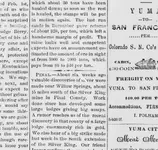Azquester
Bronze Member
- Joined
- Dec 15, 2006
- Messages
- 1,737
- Reaction score
- 2,603
- Golden Thread
- 0
- Primary Interest:
- All Treasure Hunting
Good Day Matthew,
I had just deduced that first water must be willow springs from Google Earth and the map of Weavers Needle waltz left so does that mean second water is Carney Springs?
Thanks in advance.
I had just deduced that first water must be willow springs from Google Earth and the map of Weavers Needle waltz left so does that mean second water is Carney Springs?
Thanks in advance.
In the question Greg asked about First water and Second water;
Second water definitely was not named until after the turn of the century, to late for Waltz to have known it as such.
First water creek was not always known by that name, exactly when it became established is anyone's guess.
Waltz said, "go to First water, then go to Second water ...... "
If Second water was a well known place name Waltz would have simply said, "go to Second water". There would have been no reason to first say go to First water.
The first water reference was something Waltz knew Holmes would specifically recognize and thereby from that water source lead him on to the second water he was talking about.
Waltz knew Holmes had followed him into the mountains to a certain point. All Waltz had to do was orient Holmes and direct him from that point forward.
Neither water source Waltz gave had an established name so Waltz had to first orient Holmes to something he knew Holmes would recognize and understand.
Willow Spring in West Boulder Canyon was not known as Willow Spring in Waltz's life. That name came later. The old Government Well was known at one time by the name Willow Spring and that is where I believe Bicknell was located.
Also, Peralta Canyon was known as Willow Canyon in the old days and a seep near where Adam Stewerts cabin was located was called Willow seep.
It's confusing to say the least and in Waltz's time as Greg Davis pointed out, few places had established names and even fewer of those places were widely known by people.
Maps were rare and often the same place had several names depending on who you were talking to.
To think Waltz was directing Dick Holmes and Gideon Roberts to his mine using the same place names in the Superstitions we know today is a big mistake.
That's my take on things.
Matthew








